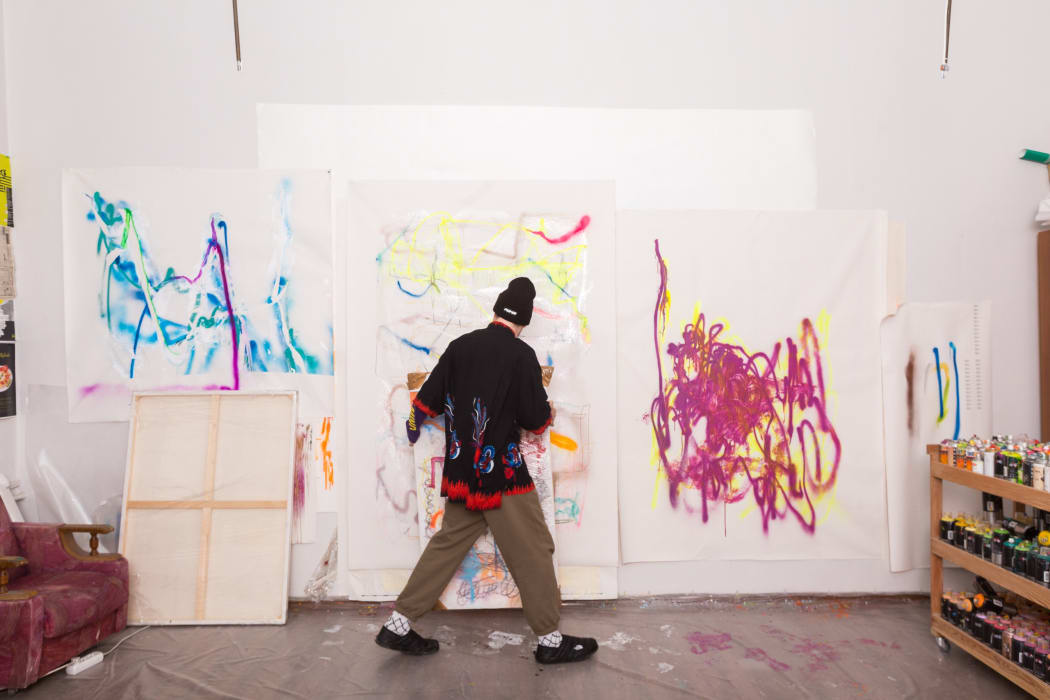
In your "twice shortened creative biography," you describe yourself as an "artist," highlighting the "roles" of a writer, musician, artist, and curator. Is it possible to discuss any of these aspects as the primary one?
They all exist in specific builds. The task of my creative schedule is to make these builds most effective. There is no problem with painting; it goes with everything. The important thing is the space. Recently, I discovered several ways of producing graphics because it seemed to me that I was diminishing myself: before, I did not quite understand how to transmit the energy of the canvas into graphics. Now, painting is possible for me even in extreme conditions; I called it the "guest option" - even when there is no studio.
Sometimes, of course, one of my roles comes to the fore, depending on tasks and plans, but I think I have learned to manage it all. I like curating because it has a degree of creating reality faster than when you are an artist. For example, you can create a fantastic exhibition in two months. You do all the negotiating yourself. Curating implies a different shade of responsibility than art practice.
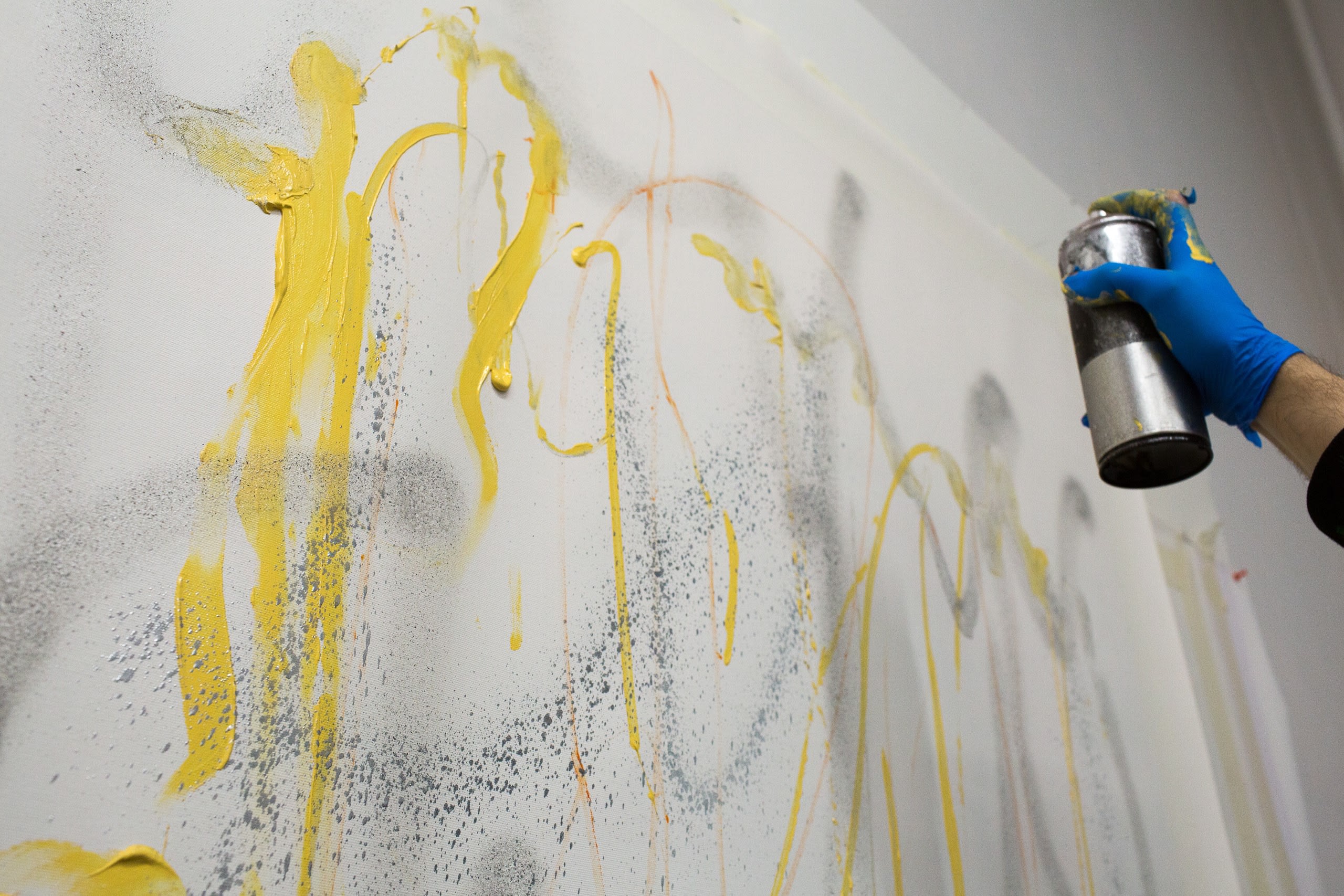
How do you separate the "roles"? Do you see curatorial work as an e
xtension of your artistic work, or is it a separate project? Are there difficulties in making arrangements between Ustinov, the artist and Ustinov, the curator?
Yes, it gives me a strange feeling. This is why I began making my summary and went through the archives; I felt that I was doing something all the time but still missed something. Then, when it came together, I realized that many things were simply in progress, and the picture became clearer. For example, llil.space (note: Ustinov’s Gallery in Rostov-on-Don) is a breakthrough between these roles or, I guess you could say, a breakdown (laughs). I was organizing this gallery, and Iwas a little embarrassed that I, as an artist, would still be exhibited in my own gallery, but both of the projects I did there would have been simply impossible to do elsewhere.The first project was a painting project; the second was with icons. Indeed, there were conflicting moments with myself when it comes to graphic; yes, I felt it was time to pull the trigger and leave the painting alone in the Rodchenko Art school.
I like the term "artist" a lot. It is so ghastly on the one hand, but on the other, it is cool as it is one of the suggested representations on Instagram.
The origins of this probably lie in responsibility: in Rostov in 2006, you knew that there would not be any pace for your statement if you did not organize one. Naturally, within the process, the curatorial drive comes into play. I am more of a curator of material, place and understanding of the artist. In the way I function as a curator, a big part comes from the artist.
Before entering the Rodchenko School, you participated in the Rostov "ZhiCh: (SS - "Жаба и Черт" - "Toad and Devil") project, making "provocative" art. Talking about the School, you often highlight a moment of confrontation, that you went from the opposite, doing painting because it was not trendy because no one else was doing it. What do you think is provocative now?
At the Rodchenko School, I responded with provocation to provocation. Two things came together: on the one hand, I was wildly interested in it, I felt it was part of my artistic body, and on the other, there was a particular drive. Bratkov (professor of the Rodchenko Art School) said, "Give me a provocation" and I gave him a canvas. And now, it is no secret that this workshop produces painters and excellent painters. Of course, it is my choice and not mine either: I found myself in many situations where I did not understand why I was acting as a litmus test. I certainly see it as some artist's destiny, but on the other hand, sometimes there is simply no other choice. I can say straight away that this is not the position of a difficult child; on the one hand, it is a reaction to the situation, but on the other, it is a defence of my directions and interests.

I am acting locally now, in Rostov-on-Don. Moreover, I understand that the public's perception of art does not result from our southern city's peculiarities; the organizations and people that exist here have not created an artistic situation, a platform for the art perception. What should I do in this case? Should I talk about it? This is one level of confrontation. In Moscow it would be different. Some hidden mechanisms show themselves all the time, maybe because my literary project demands it.
Being a cross-media artist, do you insist that painting is a self-contained medium?
I am more interested in mixing things up in different boxes, but now I combine painting, for example, and other media and moves in an exhibition. Yes, I have now come to the point where I want to sharpen or combine methods, but the "roles" themselves do not overlap yet.

I want to separate the projects because otherwise, it turns out that they all will be connected through the artist's personality. The project will have a different connotation through this connection.
In my opinion, abstract painting is already very expressive. In combining different creative roles in one work, there is a kind of additionality and joke that is not always appropriate.
Speaking about your painting style, you note the influence of the traditions of the Soviet avant-garde and abstract expressionism. There is a rather specific perception of these phenomena in the post-Soviet space, probably primarily due to Soviet censorship. Do you think that Russian viewers today are ready to talk about abstract painting more seriously, moving away from the anecdotal "I can do that too"?
I do not feel that way. In the Russian context, I can count abstract artists on the fingers of one hand, and there are even less extraordinary abstract artists. It is strange when your commitment to abstract painting is perceived as something very commercial, while speculative painting is valued higher at the same time. It is a strange thing.

I always want to get away with opening my exhibition in Russia. There seems to be some discharge; people see your work and are like, "yeah, so what?". It is such an incommensurable gap between the work and its perception. You often do not have time to switch from "artist" mode to "viewer" mode. Often you want to hear support, but you do not get it, and you communicate with acquaintances or friends rather than with the viewer.
Does contact with the viewer matter to you?
In your curatorial practice, when you encounter people coming to an exhibition for the first time in their 30s, you realize that it is silly to demand any great movements from the viewer. Yes, I would like to raise the perception somehow; it would be nice. Obviously, you always work for yourself. Perhaps you need to get rid of this expectation... It would be nice to raise the degree of the viewer's attention.
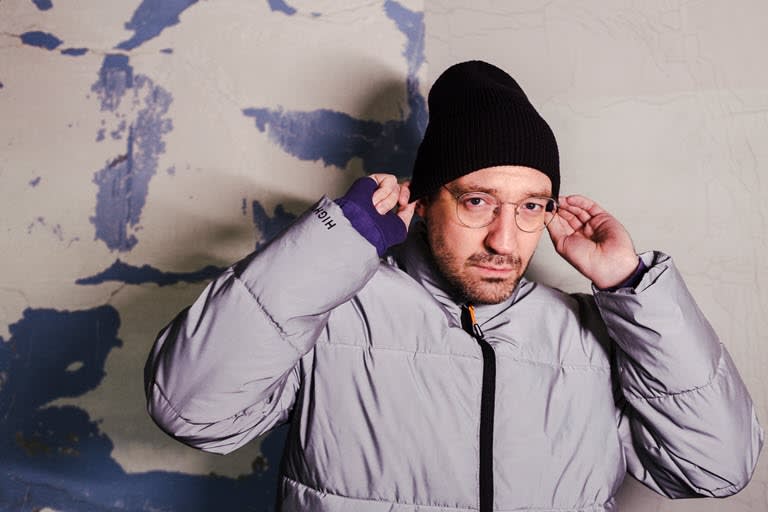
In the last series of paintings, "Text Becomes Line," you turn to your literary side as an artist. Still, does Ustinov the writer sometimes appear in Ustinov the artist's projects?
There are two critical caveats there. Yes, I can add some quotes to the canvas, but I am weaving it down to the aura of writing. I am not interested in the conceptualist tradition of being the illustrator of my books or anything like that. Maybe it comes from the situation in the '00s and '10s when there was a feeling that art in Russia was overloaded with text. There were crutches for paintings - additional inscriptions on the canvas (in my opinion, absolutely superfluous). I rarely like this.
Let the visual speak its language. Giving up both the image and the text is difficult: you create a universe that is complete, and it is unclear, how it will affect you.
A few lines act like atmospheric pressure: nothing happens, but you shift your perception. This what interests me. I sometimes stray from that path and think I have set too strict rules for myself and need to break them, that I will do a series with faces or something, but I quickly become uninterested in it. The principle of "portrait production" seems too easy; I generally understand how to do it, and maybe I will do it someday.
I know you are working on your first book right now. Can you tell us what it is about?
This book takes place in an art community reminiscent of the Russian one; it is about alternative ways of developing such a community. Now I am making every effort to make this journey fascinating so that even the chapters describing sad events have a touch of satire.
I have now also come to some horizon-broadening stuff. I quickly realized that you could work on multiple paintings and even multiple series of paintings at once. It is more of a movement that way. So, you do not have to "get into" the work. Furthermore, it became clear that I can do that, too, so I am currently writing three books: a collection of short stories and two novels. A book, like a painting, grows from different pieces. I present the plot, but I do not write linearly.
Why Harry Poterr is your main character?
First of all, the situation itself, where the inhabitant of this beautiful country asserts himself in every way as a Muggle, and secondly, much in art is done intuitively, like magic. This sense of magical perception will change. One wants to cast much light on the situation. The exhibition was called "Re-enchantment", and the procedure preceding the re-nchantment should be "un-enchantment". I want to unwind this situation somehow.
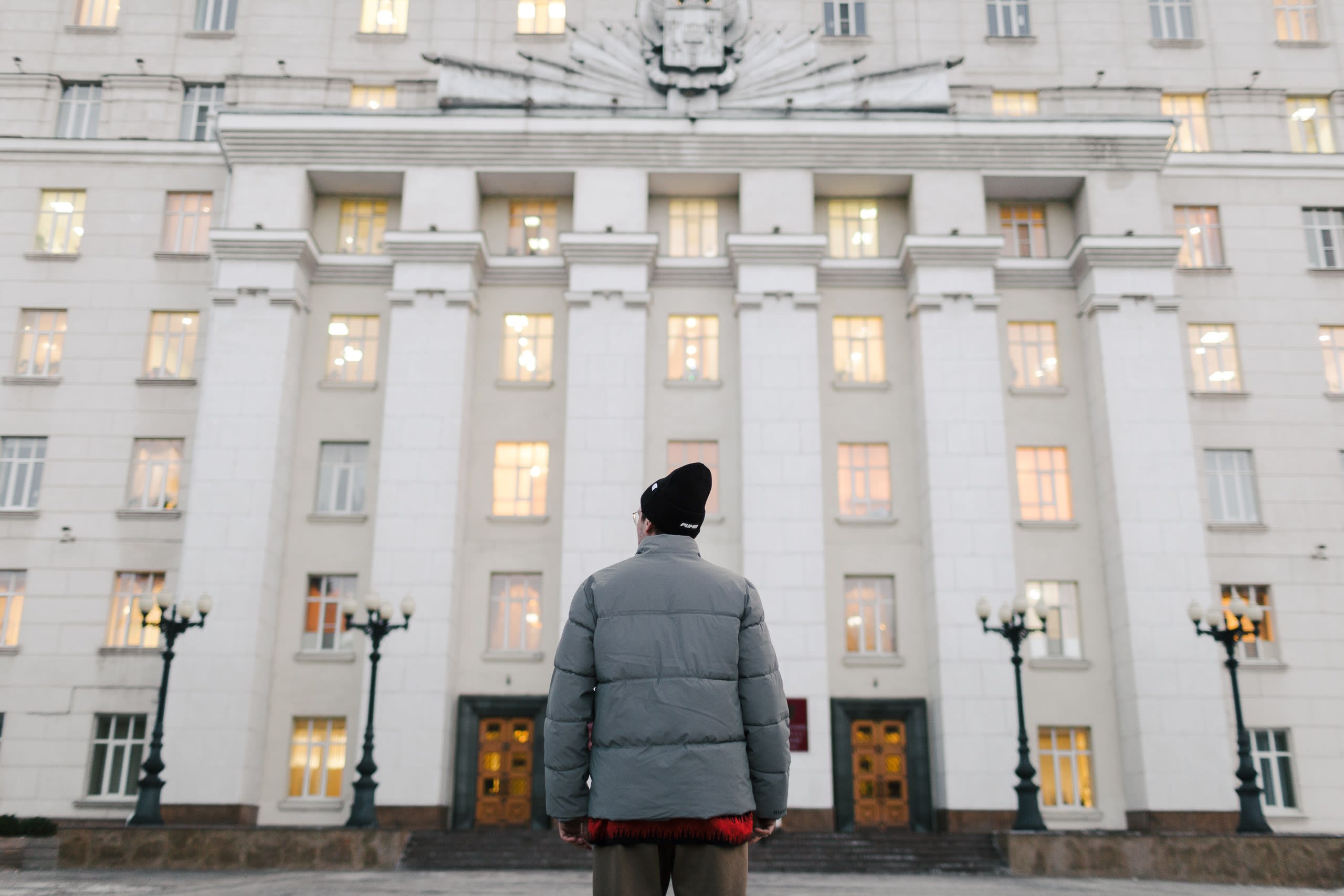
To peel off that extra-label, like on some products in the store, and read what is written underneath it. I was left with the feeling of the "extra-label" when I was in an art environment, and that label was fluttering in the wind. I do not understand why you cannot take it off and show what was originally written.
In one of your recent curatorial projects, "Entrance to the Underpass" (S.S. - "Вход в переход" in Russian) you address the Soviet heritage in Rostov-on-Don. Do you feel like a Rostov artist?
Of course, I feel the underground influence, a strong one. Rostov is more of a musical city than an artistic one. There are important hip-hop groups and people who revived the guitar scene. I can single out two important examples for me: Basta and Motorama, who have several different side-projects. If you remember, ten years ago, it was not fashionable to sing in Russian; they changed that situation, restarted it. The '90s were such a boiler, where designers often did artistic, architectural, and other projects. I, for example, was influenced by Sergey Nomenkov, who gave us our first exhibition in Rostov, by Vadim Makhnitsky, still an underground artist. However, I cannot say that there is any Rostov scene.
I started with music. And when we declared ourselves artists, it became clear that we had to create events in the city, do hybrid activities. We were doing "broken parties." It seemed like it would be easier to reach the audience that way. My first art project was a party. We asked kids from 3 art schools to make UFO-themed drawings and filled the space of an underground nightclub with them.
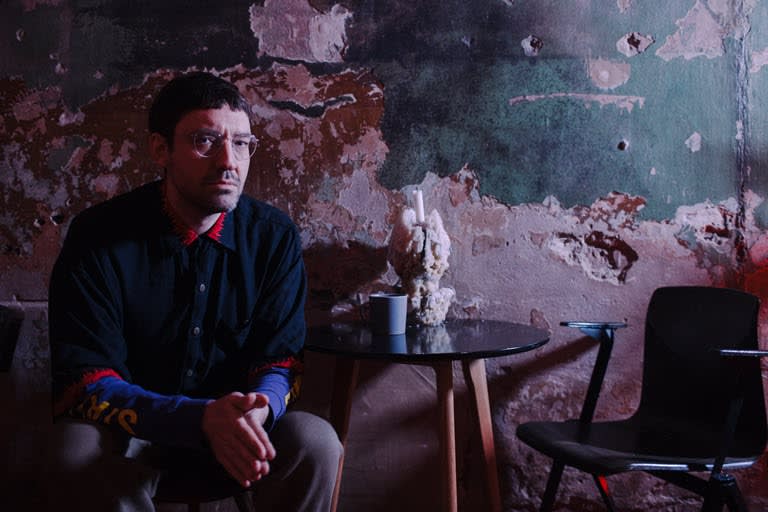
I am in touch with Sasha Selivanov and Lyubov Kulik, but basically, there is no artistic setting here. Up to a certain point, this vacuum helps me to do my projects. There were many distractions in Moscow.
What is next? Are you working on any projects now?
In painting, I am working on a combination of approaches, but not within broad creative vectors: I am now doing a painting where I need to achieve persuasiveness with two colors, lines, and movements. And, of course, I am working on completing books and the gallery project llil.space.